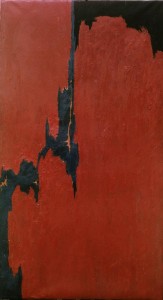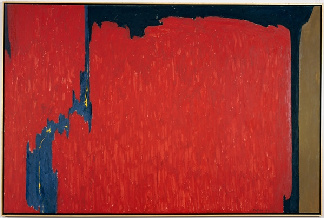By Dean Sobel, Director
In choosing works for the new exhibition, More Discoveries: Inaugural Exhibition, Part II, I came across a slide, most likely taken as part of an inventory in the 1960s, of a tall painting with a particularly expressive, vertical form executed in orange and black. This painting — PH-191, 1951 (seen below, on the left)—had always impressed me, as it seemed to be a strong, singular embodiment of the “classic” vertical image that Still had perfected in the early 1950s. I recognized that the painting’s tall, almost skinny format was also unique (it measures 82 x 45 inches), given that many of his works at this time were growing broader in their dimensions.
Upon unrolling this painting, we found an inscription on the back, which noted that this painting was, in fact, a fragment cut from a larger work. It was signed and given a PH (inventory) number, proving it was intended by the artist to be a discrete work of art.
On a recent trip to New York I visited the room of Stills at the Metropolitan Museum of Art, I was struck by the similarities between PH-191 and the left portion of one of the Met’s paintings, PH-803, which dates from 1950 (seen below, on the right). Perhaps the CSM painting was initially part of a “replica” of PH-803 — the many examples in which Still made additional versions of major works. Or, perhaps, he ultimately might have felt that all he wanted to say was already encapsulated within the power of this single image, set against a particularly expressive, oxblood red background. At present, no documentation exists for the larger work from which PH-191 was borne. Seeing it in the galleries, I’m certainly glad he didn’t throw this “fragment” out. See it for yourself in the exhibition.
This question will continue to be explored through conservation. I have asked our paintings conservator, James Squires, to examine this question and we look forward to sharing our discoveries with you in another post.


